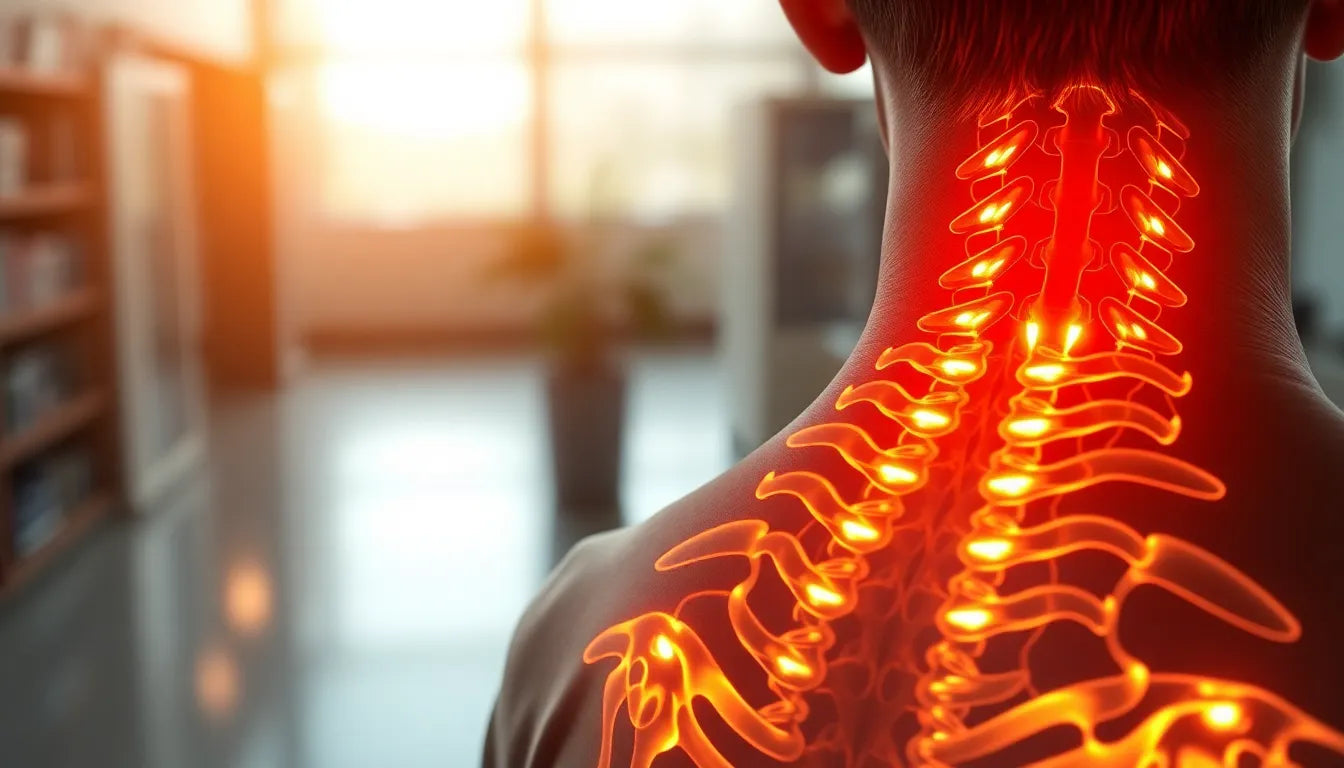Back pain is a common ailment that affects millions of people worldwide, often disrupting daily activities and diminishing quality of life. Among the numerous causes of back pain, a herniated disc stands out as a significant contributor. Accurate diagnosis of a herniated disc is crucial for effective treatment and recovery, as it enables targeted therapeutic interventions and helps prevent further complications.
understanding herniated discs
A herniated disc, also known as a slipped or ruptured disc, occurs when the soft inner gel of a spinal disc pushes through a tear in its tougher exterior. This can lead to irritation or compression of nearby nerves, resulting in pain, numbness, or weakness in the back, legs, or arms, depending on the location of the herniation. The condition is most prevalent in the lower back (lumbar spine) but can also occur in the neck (cervical spine).
Proper diagnosis of a herniated disc is essential because it not only confirms the presence of the condition but also helps in identifying the exact location and severity of the herniation. This information is vital for crafting a personalized treatment plan that addresses the specific needs of the patient, whether it involves conservative management, such as physical therapy and medication, or more invasive measures like surgery.
the goal of this post
The purpose of this blog post is to guide you through the comprehensive approach used to diagnose a herniated disc effectively. By understanding the diagnostic process, you will be better equipped to navigate your medical consultations and make informed decisions about your health. From initial assessments to advanced imaging tests, we will explore the various methods healthcare professionals employ to ensure an accurate diagnosis. This knowledge will empower you to engage proactively with your healthcare provider and set realistic expectations for your diagnostic journey.
initial assessment for diagnosing a herniated disc
Diagnosing a herniated disc begins with a thorough initial assessment, which is pivotal in guiding further diagnostic steps. This phase involves a comprehensive review of the patient's medical history and a detailed physical examination. These steps help healthcare providers gather essential information to identify the likelihood of a herniated disc and determine the need for advanced diagnostic tests.
importance of medical history review
Understanding a patient's medical history is foundational in diagnosing a herniated disc. Physicians focus on several critical elements during this review:
- Past injuries and pain characteristics: Information about previous back injuries or episodes of pain can provide insights into potential causes and patterns.
- Symptoms: Patients are asked about symptoms such as numbness, weakness, or changes in urinary or bowel function, which can indicate nerve involvement.
- Red flags: Unexplained weight loss, fever, or other systemic symptoms are noted, as they may suggest more serious underlying conditions.
physical examination techniques
The physical examination is a critical component of the initial assessment, involving several specific tests to evaluate the spine and surrounding structures:
- Straight Leg Raise Test: This test involves the patient lying flat while the doctor gently lifts each leg. Pain during this maneuver can indicate nerve root irritation due to a herniated disc.
- Gait Monitoring: Observing the patient's walking patterns can reveal abnormalities that suggest nerve or muscular issues.
- Lumbar Spine Examination: Doctors assess the lumbar region for signs of inflammation, tenderness, or sensitivity, which can indicate a herniated disc.
- Neurological Assessment: Reflexes, sensation, and muscle strength are tested to identify nerve compression or damage.
- Range of Motion Tests: These tests evaluate the spine's flexibility and identify movements that trigger pain.
imaging tests for herniated disc diagnosis
When the initial assessment suggests a herniated disc, imaging tests are often employed to confirm the diagnosis and assess the extent of the condition. These tests provide detailed visualizations of the spine and surrounding tissues.
mri: the gold standard
MRI (Magnetic Resonance Imaging) is widely regarded as the gold standard for diagnosing herniated discs. This non-invasive test uses magnetic fields and radio waves to produce detailed images of the spine, allowing doctors to see the herniated disc and any associated nerve compression clearly.
ct scans and x-rays
While CT scans and X-rays are not typically used to directly diagnose herniated discs, they play a crucial role in providing additional information. CT scans offer cross-sectional images that can help rule out other conditions, such as fractures or tumors. X-rays, although not showing soft tissues like discs, are useful for assessing the overall alignment and structure of the spine.
myelogram
A myelogram is a specialized test used in certain cases where more detailed information is needed. It involves injecting a contrast dye into the spinal fluid, followed by a CT scan. This test can highlight nerve compression and is particularly useful when MRI results are inconclusive.
specialized tests for complex cases
In some instances, additional specialized tests are required to confirm nerve involvement or to inform surgical decisions. Electrical tests, such as Electromyography (EMG) and Somatosensory Evoked Potentials (SSP), measure the electrical activity of nerves and muscles, providing valuable data on nerve function and damage.
By understanding the comprehensive approach to diagnosing a herniated disc, patients can engage more effectively with healthcare providers and make informed decisions about their treatment options. The combination of medical history, physical examination, and advanced imaging ensures an accurate diagnosis, paving the way for effective management of this common yet impactful condition.
approaches to diagnosing a herniated disc
Diagnosing a herniated disc involves a systematic approach that integrates clinical expertise with advanced diagnostic tools. Medical professionals leverage a combination of initial assessments, imaging tests, and specialized evaluations to ensure a comprehensive diagnosis. This approach not only confirms the presence of a herniated disc but also provides insights into its severity and impact on surrounding structures.
clinical focus in medical institutions
In medical centers, a formal approach to diagnosing a herniated disc is often employed. This involves detailed procedural explanations and a focus on identifying emergency indicators. The process begins with a careful review of the patient's medical history and a thorough physical examination. These steps are crucial in determining the necessity for further imaging tests, such as MRI or CT scans, which are key in visualizing the spine and confirming the diagnosis.
patient-centered diagnostic process
From a patient’s perspective, understanding the diagnostic process can significantly ease anxiety and improve communication with healthcare providers. Framing the information as a "Patient's Guide" helps in anticipating concerns and explaining post-diagnosis steps. Patients are encouraged to actively participate in discussions about their symptoms and treatment options, fostering a collaborative approach to care.
symptom-focused diagnostic approach
Leading with symptoms can be an effective way to engage patients and provide clarity before delving into diagnostic procedures. By focusing on common symptoms such as back pain, leg pain, numbness, and muscle weakness, healthcare providers can better tailor the diagnostic process to the individual’s needs. This symptom-focused approach ensures that patients understand the relevance of each test and how it contributes to the overall diagnosis.
visual tools in diagnosis
Incorporating visual elements such as tables or images can enhance understanding of diagnostic tests and positions. Visual aids can illustrate how tests like the straight leg raise or range of motion assessments are performed, providing patients with a clearer picture of what to expect during their evaluation. These tools can also highlight the differences between cervical and lumbar herniated disc diagnoses, emphasizing the unique considerations for each type.
cervical versus lumbar herniated disc diagnosis
While the diagnostic process shares similarities, there are distinct differences between diagnosing cervical (neck) and lumbar (lower back) herniated discs. For cervical herniations, symptoms often include neck pain, shoulder pain, and arm numbness. In contrast, lumbar herniations typically present with lower back pain, leg pain, and foot numbness. Understanding these differences is crucial for accurate diagnosis and effective treatment planning.
Frequently Asked Questions
What are the most common symptoms of a herniated disc?
The most common symptoms include back pain, leg pain, numbness, and muscle weakness. The specific symptoms depend on the location of the herniation and which nerves are affected.
When should I seek medical attention for back pain?
It is important to seek medical attention if you experience severe pain, persistent numbness, or changes in bladder or bowel function. These symptoms may indicate a more serious condition that requires prompt evaluation.
How long does the diagnostic process take?
The timeline for diagnosing a herniated disc can vary. Initial assessments and physical examinations are typically conducted during the first visit, while imaging tests like MRI may require scheduling and additional time. Overall, the process can take from a few days to a couple of weeks, depending on the complexity of the symptoms and the availability of diagnostic resources.
Can a herniated disc heal on its own?
In some cases, a herniated disc can heal over time with conservative treatment such as physical therapy and medication. However, if symptoms persist or worsen, medical intervention may be necessary to prevent further complications.
What are the treatment options after diagnosis?
Treatment options for a herniated disc include physical therapy, pain management with medications, and in some cases, surgery. The choice of treatment depends on the severity of the symptoms and the specific needs of the patient.
Sources
- NYU Langone Health. "Herniated Disc Diagnosis."
- Cleveland Clinic. "Herniated Disc: Diagnosis and Tests."
- UCHealth. "Spine Care: Herniated Disc."
- Penn Medicine. "Herniated Disc."
- Weill Cornell Neurological Surgery. "Herniated Disc."
- University of Maryland Medical System. "Herniated Disc."
- WebMD. "Herniated Disk: Symptoms, Causes, and Treatments."


















